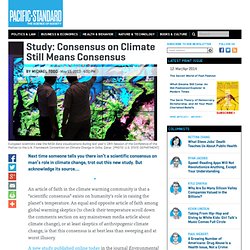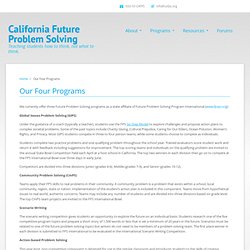

Consensus on Climate Still Means Consensus - Next time someone tells you there isn’t a scientific consensus on man’s role in climate change, trot out this new study.

But acknowledge its source…. An article of faith in the climate warming community is that a “scientific consensus” exists on humanity’s role in raising the planet’s temperature. An equal and opposite article of faith among global warming skeptics (to check their temperature scroll down the comments section on any mainstream media article about climate change), or at least skeptics of anthropogenic climate change, is that this consensus is at best less than sweeping and at worst illusory. A new study published online today in the journal Environmental Research Letters puts a figure on how real this (genuine) scientific consensus is. The takeaway figure? I see value in continuing to hammer home that the scientific establishment has reached a consensus that people are warming the planet (and perhaps that people can cool it down).
Www.nais.org/Articles/Documents/Criteria_Challenge2020_August2007.pdf. FPSPI. Cracking Creativity: The Secrets of Creative Genius: Michael Michalko: 0028195083110: Amazon.com. Athene's Theory of Everything. 5 Terrible Ideas That Solved Huge Global Problems. The ability to think outside the box is a valuable skill that tends to bring its possessor fame and fortune.

But there's a fine line to be balanced -- if you think too far outside the box, the best you can hope for is that your padded cell is somewhat clean. Yet sometimes, the most far-fetched, cartoonish ideas are the ones that work best. All it takes is the right idea and the ability to convince somebody to spend lots of money trying it. #5. Tokyo Decides to Prevent Crime With Mood Lighting The Plan: Nearly every city in the world wishes it could flip a magic switch that would cut down on crime, and only one city has a switch that turns on the Bat Signal. PsychcentralThat's the sign for robot prostitutes. Yeah, right. How It Worked: Oh, wait, it totally did. And piped in some smooth jazz. Next, the Tokyo railroad decided to get in on the blue-light action, though the problem they wanted to solve wasn't so much the crime. Seriously? Getty"I just can't leave a world that invented The Smurfs.
" The Six Step Model - Global Issues Problem Solving. We currently offer three Future Problem Solving programs as a state affiliate of Future Problem Solving Program International (www.fpspi.org): Global Issues Problem Solving (GIPS) Under the guidance of a coach (typically a teacher), students use the FPS Six Step Model to explore challenges and propose action plans to complex societal problems.

Some of the past topics include Charity Giving, Cultural Prejudice, Caring for Our Elders, Ocean Polution, Women’s Rights, and Privacy. Most GIPS students compete in three to four person teams, while some students choose to compete as individuals. Students complete two practice problems and one qualifying problem throughout the school year. Competitors are divided into three divisions: Junior (grades 4-6), Middle (grades 7-9), and Senior (grades 10-12). Community Problem Solving (CmPS) Teams apply their FPS skills to real problems in their community. Scenario Writing Action-based Problem Solving. Students take on world's challenges. For high schoolers, 20 years might as well be a lifetime.

But hand them a problem that experts say threatens the entire planet if not solved in the next two decades, and they'll simply get to work. Perhaps the most hopeful sign for the rest of us: They'll have fun while they're at it. Subscribe Today to the Monitor Click Here for your FREE 30 DAYS ofThe Christian Science MonitorWeekly Digital Edition A prime example was an ebullient group of teenage girls, a whirl of blue jeans and saris amid hundreds of teachers and students gathered for a conference recently in Boston.
That's the topic they selected as participants in a new initiative called Challenge 20/20.